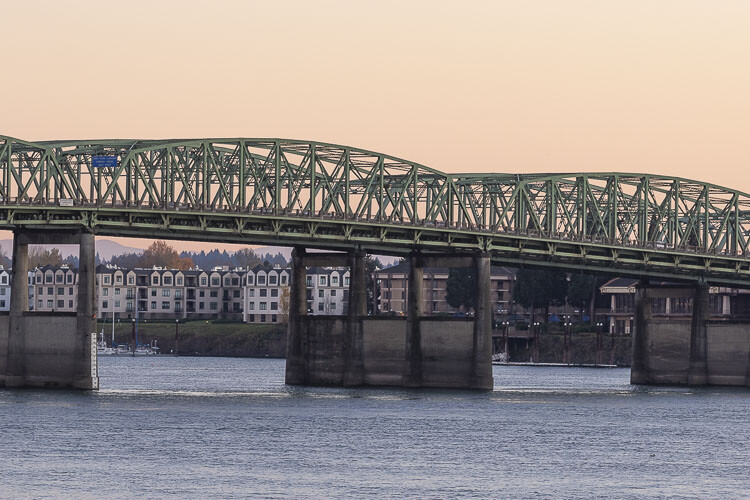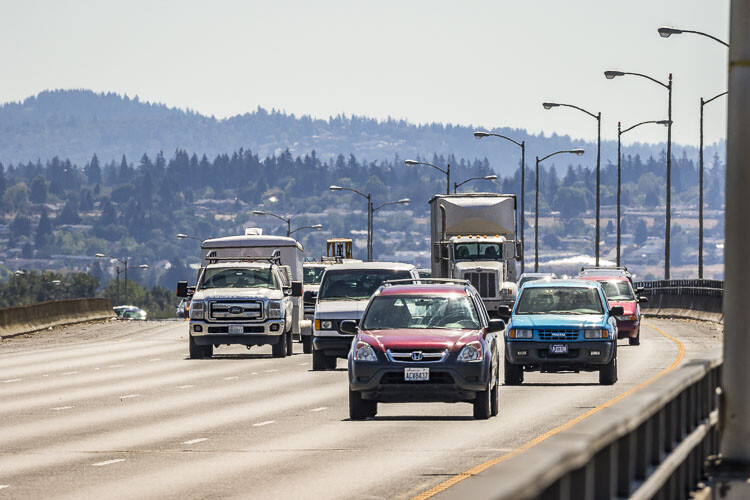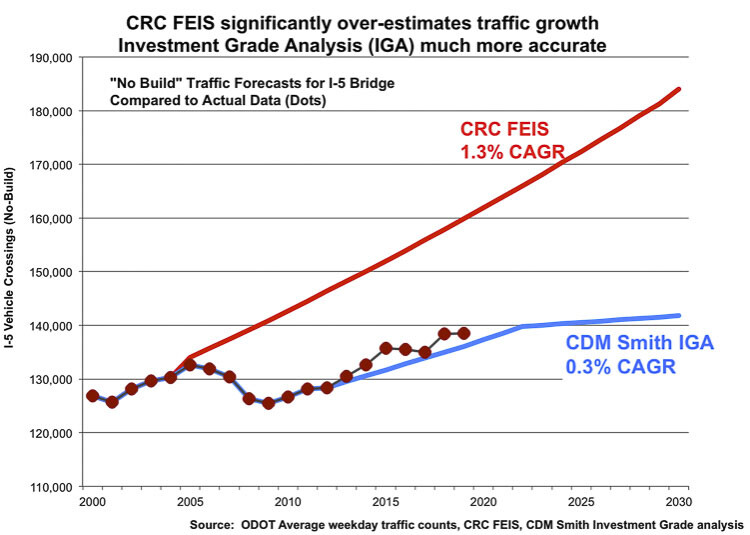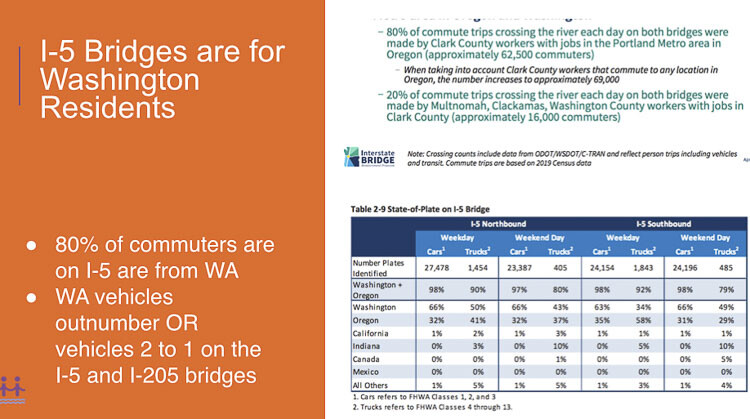
City Observatory has carefully studied the proposed Interstate Bridge Replacement project and identified serious flaws which endanger this project
Joe Cortright
City Observatory
Here are our 16 top reasons Oregon and Washington need to re-think the proposed Interstate Bridge Replacement Project. The bloated size of the project and its $7.5 billion cost, and the availability of better alternatives, like a bascule bridge, call for rethinking this project now.
- It’s not a bridge, it’s a freeway widening and interchange rebuilding project. Contrary to the project’s name, it’s not merely a “bridge replacement.” The bulk of the cost is widening 5 miles of freeway and rebuilding 7 major interchanges. IBR’s own “River Crossing Options” study says the proposed IBR bridge only costs $500 million.
- The budget is out of control: $7.5 billion. In 2020, the IBR was projected to cost a maximum of $4.8 billion. The price tag for the project jumped 54 percent in December, 2022. The total cost is now estimated at $7.5 billion, but ODOT has a long history of having its major projects end up costing twice as much as budgeted. Contrary to claims made by the IBR, recent construction cost inflation accounts for only $300 million of the more than $2.5 billion cost increase since 2020.
- A tunnel or bascule bridge would be vastly cheaper, avoiding the need to widen the freeway and rebuild intersections. IBR’s design will allow only 116 feet of navigation clearance, and IBR has refused to seriously consider either an immersed tube tunnel or lower level bascule bridge, both of which would eliminate most or all bridge lifts, and eliminate the need to rebuild intersections on I-5. The I-95 Woodrow Wilson Bridge in Washington DC is recently constructed bascule, and carries twice as much traffic as the I-5 bridges.
- It’s really a 12-lane wide freeway. The IBR likes to describe the project as just adding “auxiliary lanes” to I-5, but a close look at its actual plans shows it will build a 164-foot wide highway bridge–enough for as many as 12 lanes. Once built, ODOT and WSDOT can easily re-stripe this very wide structure as a 12-lane roadway.
- ODOT is ignoring the Coast Guard’s direction. The Coast Guard, which has authority to regulate bridge height–says that IBR’s bridge needs to have a 178-foot clearance over the Columbia River. With the CRC, the failure to follow Coast Guard guidance resulted in a costly year-long delay as the project was redesigned.
- ODOT’s high, fixed span crossing creates dangerous and expensive elevated roadways and steep on-and-off ramps. The IBR would have a main span with a grade of 4 percent, higher than almost every interstate bridge in the US, and ramps would have 6-7 percent grades. The steep grades will slow trucks and create dangerous conditions in winter weather.
- Planned tolls of up to $5.69 each way will permanently reduce traffic to less than 90,000 vehicles per day (from 135K today). IBR has refused to release its proposed toll rates. Documents obtained by public records request show IBR is looking at tolls as high as $5.69 each way at the peak hour. According to the Investment Grade Analysis performed for the Columbia River Crossing in 2013, even $3 tolls would permanently reduce traffic on I-5 to less than 90,000 vehicles per day–dramatically below its current traffic level of 135,000.

- High IBR tolls would produce gridlock on I-205. The IBR project plans to toll the new I-5 bridge, but not the parallel I-205 Glen Jackson Bridge. The Investment Grade Analysis prepared for the Columbia River Crossing in 2013 concluded that this would divert tens of thousands of vehicles to I-205, producing gridlock on the I-205 bridge.
- ODOT has ignored its own expert panel which recommended breaking the project into three independent phases. In 2010, Governors Kulongoski and Gregoire appointed a panel of national bridge and highway experts to review the Columbia River Crossing. They recommended that the project be broken into three separate, independent phases, to minimize financial risk. They also recommended eliminating one or more interchanges to improve traffic flow, reduce cost and simplify bridge design.
- IBR traffic projections have been proven dramatically wrong: They grossly over-estimate future traffic levels on the existing bridge, which is capacity constrained. The CRC FEIS predicted I-5 traffic growth of 1.3 percent per year; actual growth was 0.3 percent per year through 2019. They also fail to accurately predict future traffic levels. The independent Investment Grade Analysis in 2013 showed that the IBR forecasts overstated future I-5 traffic levels by about 80,000 vehicles per day, leading to the design of a grossly over-sized project.

- IBR staff altered the output of Metro’s traffic models, and increased predicted peak hour traffic on the existing I-5 bridge above that predicted by the Metro model, and in excess of the actual physical capacity of the bridge. This so-called “post-processing“–which isn’t documented according to ODOT’s own analysis procedures–inflated no-build traffic volume artificially worsened predicted future congestion, and created a false baseline for assessing the need for and impacts of the proposed bridge widening.
- The IBR project mostly benefits Washington residents. According to Census data produced by IBR, approximately 80 percent of daily commuters across the Columbia River are Washington residents. According to a license plate survey conducted for the two states, twice as many Washington cars use the I-5 bridge as do Oregon cars. Yet Oregon will have to pay just as much as Washington state, plus pay for the entire cost of the $1.45 billion Rose Quarter project (which is heavily used by Washington commuters).

- IBR has falsely portrayed the income, race and ethnicity of typical bridge users. The median peak hour drive-alone commuter from Clark County Washington to jobs in Oregon has a household income of $106,000. About 86 percent of these commuters are non-Hispanic whites. These commuters are whiter and have higher incomes than the rest of the Portland metropolitan area, and are half as likely to be people of color as the region’s population.
- IBR has no meaningful cost controls. ODOT & WSDOT claimed in legislative testimony in December 2022 that future cost escalation would be managed using a “Cost Estimate Validation Process (CEVP)” that they say had already been completed. A public records request showed that no documentation existed for the CEVP.
- IBR has put off doing an “Investment Grade Analysis” which will be required for federal TIFIA loans and toll bonds. The investment grade analysis done for the CRC showed that traffic would be dramatically lower, and tolls would have to be dramatically higher than the figures ODOT and WSDOT used to sell the CRC.
- A massive IBR will be a visual blight on Vancouver’s revitalized waterfront, and a massive viaduct across Hayden Island. The elevated approaches required by IBR’s 116 foot high fixed span are the equivalent of three Marquam Bridges side by side as they cross the waterfront in downtown Vancouver. Seattle just spent several billion dollars to remove a similar waterfront eyesore.
What we should do instead
• Refocus the project on replacing the bridge, not widening the freeway
• Re-appraise low cost options to a high, fixed span (a bascule bridge or immersed tube tunnel) that could use existing approaches and eliminate the expense of rebuilding interchanges and creating massive elevated viaducts.
• Right-size the bridge’s capacity to reflect the traffic levels that can be expected with tolling.
Also read:
- Belkot speaks before C-TRAN board; directors pause vote on light rail funding language until JulyMichelle Belkot spoke at Tuesday’s C-TRAN board meeting, calling her removal from the board unlawful; directors postponed a vote on light rail funding language until July amid legal challenges.
- Travel Advisory: Expect delays on northbound I-5 near RidgefieldWSDOT is warning travelers to expect delays near Exit 14 on northbound I-5 in Ridgefield as crews begin barrier and lane improvement work supporting future development.
- Large crowd expected at C-TRAN Board of Directors Meeting Tuesday, April 15A large turnout is expected at the April 15 C-TRAN board meeting, where public input and a key vote on light rail funding will follow the recent removal of Michelle Belkot.
- Letter: ‘The IBR needs a more cost-effective design’Bob Ortblad argues the I-5 Bridge replacement project is overbudget and inefficient, urging a more cost-effective tunnel alternative to avoid excessive tolls and taxpayer burden.
- Clark County beginning installation of upgraded traffic signals in mid-AprilClark County will begin upgrading multiple traffic and pedestrian signals in mid-April to improve safety, accessibility, and transportation technology.










Re Point #8, according to the research of Cascade Policy Institute,
The Interstate Bridge Replacement Program plans to charge tolls to cross the Columbia River on both I-5 and I-205“By the end of 2025, ODOT expects to impose tolls along the entire lengths of both I-5 and I-205 from Wilsonville to the Washington state border. After that, the Interstate Bridge Replacement Program plans to charge tolls to cross the Columbia River on both I-5 and I-205.”
full article Opinion: ODOT admits its tolls will make Oregonians worse off
Re point #7: not only are tolls planned for both I-5 and I-205 bridges, the TOLL RATES can be as high as the unelected toll commission decides and go up over time. In WA, the cost of collecting the toll has been over 50% of the cost of the toll in some cases. Tolls are an extremely expensive way to raise funds for a transportation project. Tolls enrich the tolling company at the expense of taxpayers especially truck drivers. Tolls are used to monitor the movements of drivers when transponders are used to get the Good to go pass lower rates.
Toll rates in WA on the SR 520 bridge between Seattle and east side, pay by the axle.
SR 520 Bridge tolling rates
Toll rates increase over time, the unelected tolling commission decided to
Raise the toll rates on SR 520 bridge starting July 2023 by 15%
An existing toll is a more likely measure of starting toll rates, and will surely be used by the IBR group as a justification for HIGH TOLLS to start, with future rates decided by unelected officials.
This article explains more about the secretive tolling plans ODOT has formulated..
Opinion: Driving between Vancouver and Wilsonville at 5 p.m.? ODOT plans to charge you $15
The IBR has lied to citizens and politicians about many aspects of the bridge replacement project. As Cortright notes, their “inflation” excuse to increase the cost by about $2.7 billion is a lie.
Additionally, the IBR lied when projecting I-5 corridor ridership would be 26,000 – 33,000 daily riders by 2045. In December, without explanation, they quietly lowered that number to 11,000 average daily riders. That is a 66% CUT.
Nobody rationally expects that many daily riders on mass transit. C-Tran system ridership peaked in 1999. TriMet’s ridership peaked in 2012. Neither transit system is projecting a return to pre pandemic ridership levels any time this decade.
The IBR’s projected “green house gas” (GHG) reductions were based on the 26,000 – 33,000 people getting out of cars and taking transit. Therefore the GHG reduction projections were also a lie.
The cost of the project does NOT need to be $7.5 billion. Oregon and Washington are proposing to build a bridge over the Columbia River for around $500 million, connecting Hood River with White Salmon.
This project, just like the failed Columbia River Crossing (CRC) is nothing more than a “light rail project in search of a bridge”.
https://www.wweek.com/portland/article-18881-the-2-5-billion-bribe.html
Right size is a great idea –
* We need at least DOUBLE the number of lanes.
* Since transit rider ship has fallen to LESS THAT 1000 people per day, there IS NO NEED FOR LIGHT RAIL – that trims 1-2 BILLION of the price tag.
* Since less than 200 people were walking/biking across the bridge at the time of the CRC, there is no need for special accommodations.
* Staging the intersection rebuilding (which was mostly for light during the old CRC days) will trim another few billion.
The result is a TOLL FREE bridge coming in WELL UNDER the two billion allocated/promised by the two states. So the ONLY BARRIER to building it now is special interests demanding we waste 1-2 Billion on light rail, large amounts for deluxe bike accommodations, and those opposing opposing cars because of being fooled by Al Gore’s climate scam.
BUILD IT RIGHT SIZE (MANY MORE LANES, NO RAIL, NO TOLLS) – BUILD IT RIGHT NOW!!
Right size really needs to mean no larger footprint than what is there already. Many more lanes across Hayden Island would tragically destroy the livability of the island community. There are over 3,000 full-time residents living there, businesses, and a shopping center. It doesn’t seem right that all of those people bear the price for saving a minute or two of travel time. IBRP has stated that ‘you can’t please everyone’, and that is obviously true, but a community should not be treated like it is just collateral damage.
How about having two ‘right size’ bridges built for the price of one over-priced bridge?
I’m thinking either the existing I-5 bridge is effectively seismically retrofitted or gets a same-size replacement, PLUS add ANOTHER modestly priced bridge either up or down the river from the existing I-5 bridge. Ending up with THREE choices across the river between OR and WA would probably ‘please’ a lot of travelers. When one bridge is out of action for some reason, you would still have two options.
I-5 Bridge replacement construction work is sure to require disruptive detours to the I-205 at times, or else just generally snag up I-5 traffic while heavy vehicles are moving around, bridge parts are being put into place, etc., IBRP has said their bridge construction work could last for up to 10 years, I do feel that a third bridge needs to be built BEFORE ANYTHING DISRUPTIVE is done to the existing I-5 bridge. Otherwise, it is like we are inviting even more traffic congestion nightmares for a considerable length of time.
It would be a better use of time and money to add lanes via a third bridge first. On the west side, a third bridge would provide for westside movements for goods picked up at the Port of Vancouver, or Port of Portland. As it is now, trucks get off of I-5 to head to the ports which are west of the bridge, then have to return to I-5 to cross the river, even when they are delivering to the west side. and as you point out, it would be in place when an I-5 bridge is worked on.
Consider the Minneapolis/St Paul area with many river crossings.
When the I-35 bridge in Minneapolis collapsed in 2007, the federal government and the state put a focus on replacing that collapsed bridge. In ~ 400 days. They built a brand new, seismically strong 10-lane bridge at a cost of ~ $300 million, without light rail.
http://www.dot.state.mn.us/i35wbridge/overview.html
The light rail bridge planners and proponents have wasted that much $$$ on failed bridge designs that are too low for river traffic. The planners and TriMet keep insisting on very costly light rail that Clark County voters have rejected twice at the ballot box since 2012, and serves very few commuters, perhaps 1-3%.
Light rail accounts for about a third of the proposed project cost. We could have had a new third bridge with the money squandered by the planners who want to force light rail, and OR TriMet on Clark County, WA where we have a working bus/van system that utilizes roads that can be shared with other transportation users. Light rail shares with no other transport, and carries NO freight. Roads that serve all are the lifeblood of our economy vs gold plated light rail for 1-3% of river crossings.